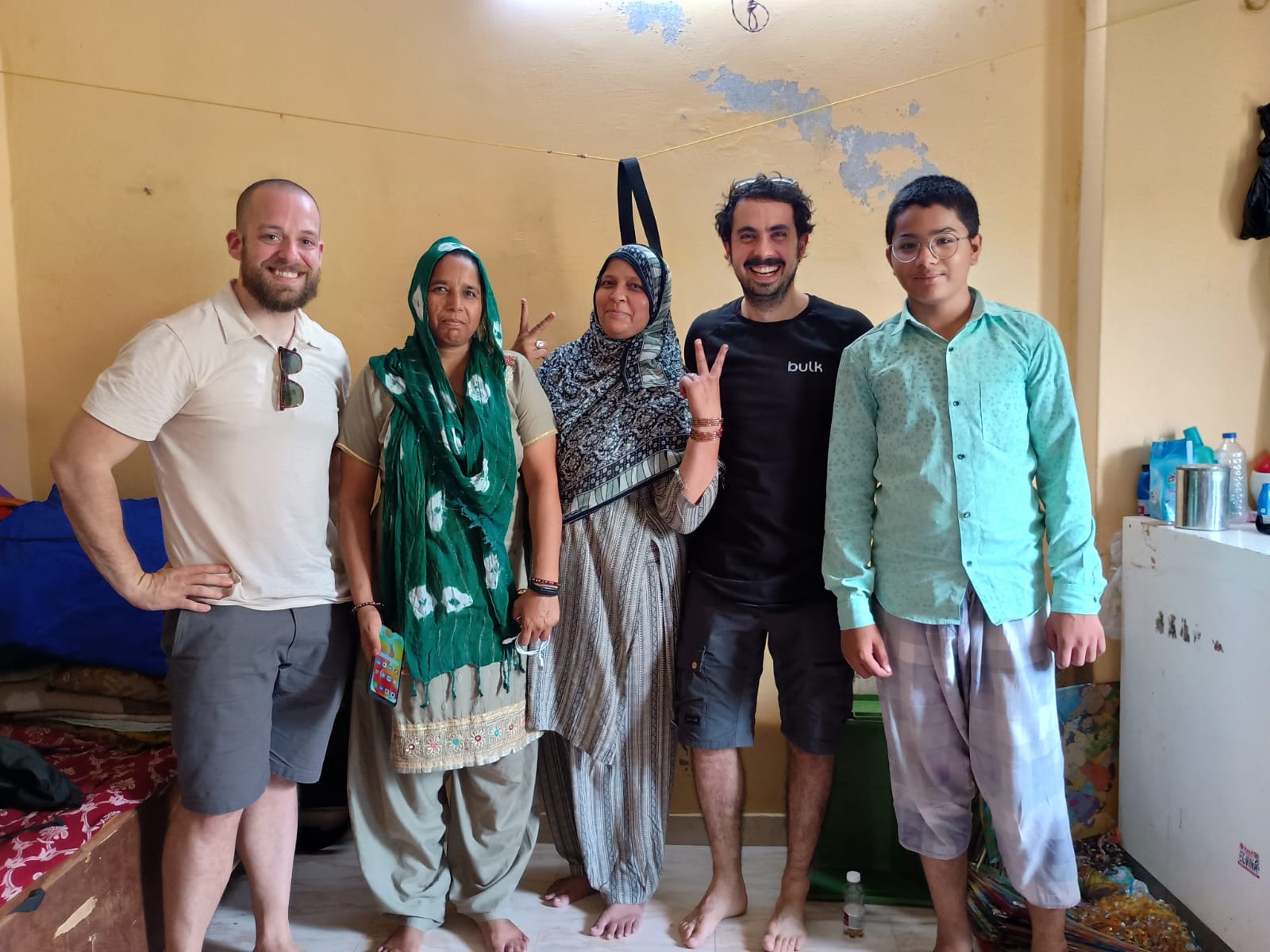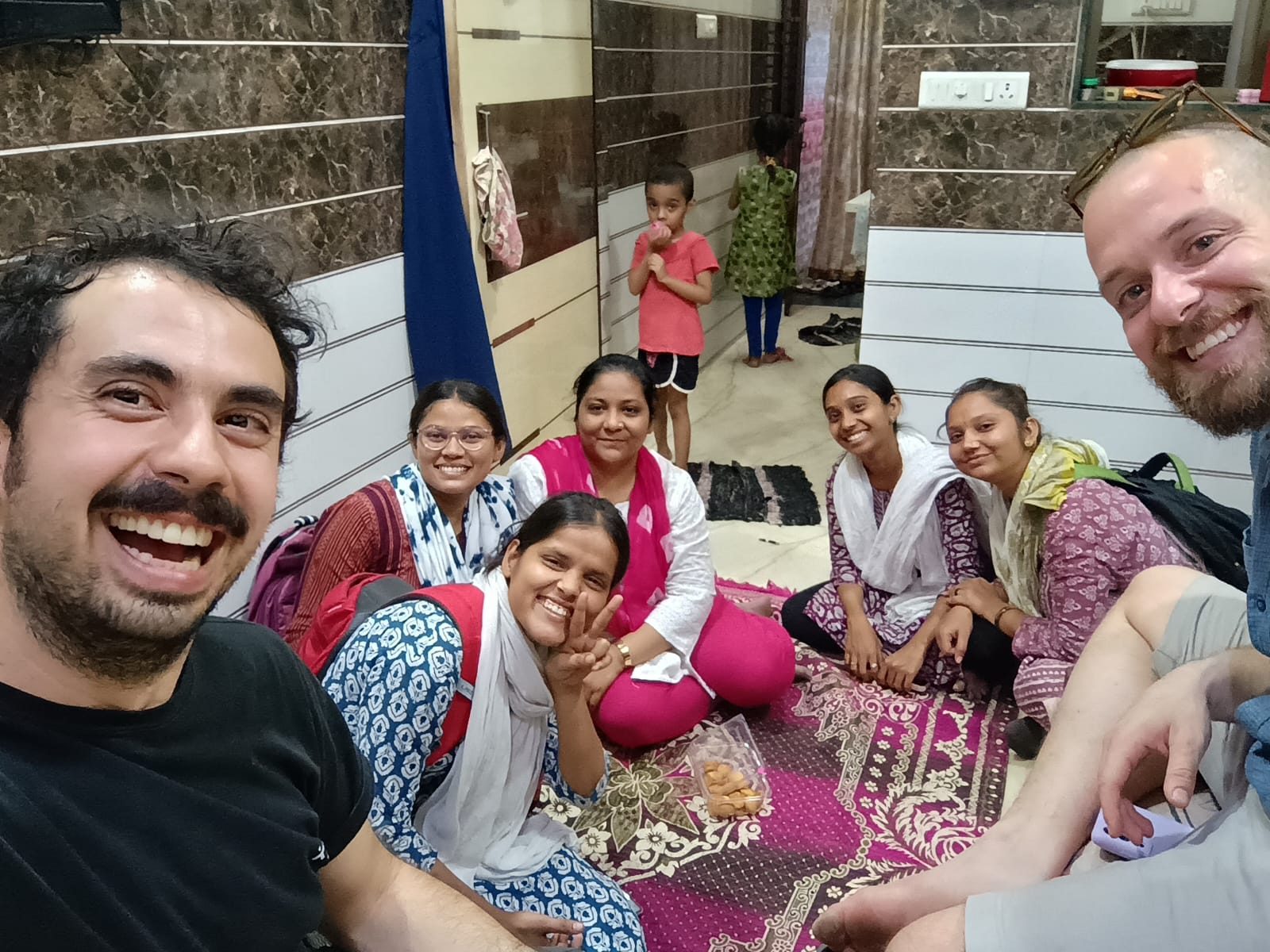The Mittal Institute’s CommunityHATS project, funded by Harvard’s Salata Institute for Climate and Sustainability was conceptualized as a way to address a major gap in the data related to heat impacts. Often macro-level data on temperature fails to capture the impacts on the most vulnerable, including informal workers who labor in exterior spaces without protection from extreme temperatures. The CommunityHATS team – led by Caroline Buckee, Professor of Epidemiology, Harvard T.H. Chan School of Public Health and Satchit Balsari, Associate Professor in Emergency Medicine at Harvard Medical School and Beth Israel Deaconess Medical Center – works with the Self Employed Women’s Association (SEWA) in India.
This summer, two members of the CommunityHATS team traveled to Ahmedabad City in Gujarat, India, to work with SEWA in deploying sensors to collect temperature data from poor working women and their environments. Their work occurred concurrently with one of the most extreme heatwaves India has ever faced.
We spoke with the two researchers, Robert Meade and Felipe González Casabianca, who provided insight into the data collection and its indications. Felipe, a mathematician and computer engineer from Colombia, is a Research Affiliate at CrisisReady who is pursuing his Ph.D. in bioinformatics at the University of Tartu. Rob, a thermal physiologist from Canada, is a Research Fellow at the Harvard T.H. Chan School of Public Health and the Salata Institute South Asia cluster.
Mittal Institute: Can you tell us about how you are using sensors to track heat impact, and what information you will get from the field project?
Robert Meade and Felipe González Casabianca: With climate change, extreme temperatures are becoming more and more common. India, for example, has experienced three straight years of severe summer heat waves. This heat represents a growing public health concern, particularly for vulnerable groups like the working poor who are often unable to limit exposure both at work and in their homes. Currently, however, we do not have a good understanding of the heat stress and strain experienced by many at-risk persons, especially those in the Global South.
Our project aims to change this. Working with the Self Employed Women’s Association (SEWA), a group of cooperatives and trade unions representing nearly 3 million poor women working in the informal sector, we will directly monitor the thermal conditions experienced by women working in the informal sector in Ahmedabad, India. The plan is to instrument the homes and workplaces of a few hundred SEWA members with environmental sensors to measure temperature and humidity and then track changes in their physiology, well-being, sleep, and movement patterns through wearable devices and regular check-ins. This will allow us to link changes in outdoor conditions (e.g., reported by a weather station) with the actual lived experience of informal workers.

Robert Meade ( extreme left) and Felipe González Casabianca (second from right) with the family of a SEWA member in Ahmedabad.
Mittal Institute: How is this information going to be used? What impact are you hoping to have with the project?
Robert Meade and Felipe González Casabianca: There are a couple of really important impacts we believe this project is going to have. First and foremost, this is going to be one of the largest data sets evaluating the thermal conditions and impacts on the body anywhere in the world. More importantly, however, a big goal of the work is to work with SEWA to develop a research platform so that they and other organizations can monitor heat stress and strain directly in their workers without the need for extensive technical expertise. This will open a huge array of possibilities, as it will allow for testing of promising heat adaptation strategies like “cool roofs” directly in the populations in which they will be applied. Such a research platform can also be used to inform other adaption strategies, like thresholds for parametric heat insurance schemes, which SEWA is currently exploring. These trigger retrospective cash transfers to workers when air temperatures cross a certain threshold. A better understanding of the impacts of heat on the body means we can fine-tune these thresholds to better protect workers’ livelihoods.
This is going to be one of the largest data sets evaluating the thermal conditions and impacts on the body anywhere in the world.
Mittal Institute: Gujarat is a heat-vulnerable state, and one of the first in the country to have a heat health action plan. How do you think the experience of working here can inform work in the rest of the country?
Robert Meade and Felipe González Casabianca: The establishment of heat health action plans is a great step, but often they leave out or do not adequately consider certain at-risk groups like the working poor who often cannot limit exposure or physical activity. We hope our study will shed more light on these issues. By working directly with SEWA, we can also ensure that any new information on heat’s impacts and the effectiveness of interventions like cool roofs will be culturally and contextually relevant and, therefore, readily translatable to community-led heat adaptation.

Grassroot leaders, with Felipe (extreme left) and Robert (extreme right), after a day of bundle deployment and data collection in Ahmedabad.
Mittal Institute: What does a typical day in the field look like for you?
Robert Meade: Felipe and I were in Ahmedabad from May 14-25 in the midst of a major heat wave. The purpose of this visit was to assist SEWA grassroot leaders in building sensor “bundles” and then deploying them in participants’ houses. On most days, we would wake up early and spend a few hours at the SEWA guest house where we were staying. Felipe would work on the study application based on feedback we received the previous day. I, who am much less technically inclined, would typically put together bundles. We would then travel to the SEWA main office and meet the grassroot leaders. From there, we would either run training sessions on how to build and deploy sensor bundles or travel to candidates’ houses to provide training on bundle deployment, where to place sensors, etc. At night, it was back to the guest house to continue working on the study applications late into the evening. Our goal was to support study implementation by the SEWA grassroot leaders.
Felipe González Casabianca: Now that both of us are back in our institutions, the SEWA team is focusing on two parallel jobs: first is recruiting more participants to the study and deploying bundles in their homes. The second is to visit the current participants’ homes to check in with them and collect the sensor data. This requires tight coordination and sister power, as every bundle needs to be collected every 20 days to avoid losing temperature data. Right now, we’re focusing on building the necessary dashboards and analytic pipelines to support SEWA with deployment and collection, as well as extracting early insight from the collected data.
Mittal Institute: What insights did you gain from this experience?
Robert Meade: The whole trip was an incredibly informative and rewarding experience. Meeting the grassroot leaders and SEWA members and experiencing the heat they’re exposed to every day really underscored the importance of the project. Even working in heat physiology research for the past decade, I have rarely experienced such extreme temperatures as I did on our trip, temperatures that these women are exposed to every day. It was also touching to see the strength of the relationships between SEWA members. It really is a tight-knit community, and both the grassroot leaders and the participants are proud to contribute to the project to improve the health and livelihoods of their community.
Even working in heat physiology research for the past decade, I have rarely experienced such extreme temperatures as I did on our trip, temperatures that these women are exposed to every day.
Felipe González Casabianca: My first thought is the overwhelming dimension of how things work in India. The geographic coverage and number of members that an organization like SEWA has is incredible, even larger than many countries. And beyond that, the way SEWA works is quite inspiring, always putting its members first, and from what we saw in the field, working non-stop to make the project happen. It’s very easy to get caught up in the science or engineering challenges of all this, but the SEWA leaders forced us to always ask: yes, but what do the sisters get out of it? This is the type of mentality that builds institutions like SEWA.
☆ The views represented herein are those of the interview subjects and do not necessarily reflect the views of the Mittal Institute, its staff, or its Steering Committee.
